Communication Management: Business Case Report, Semester Details
VerifiedAdded on 2020/02/17
|14
|5201
|37
Report
AI Summary
This report provides a comprehensive analysis of communication management within a food retail business. It begins with an introduction to the importance of systematic information and knowledge gathering, particularly during the planning phase. The report is divided into two main tasks. Task 1 focuses on assessing information and knowledge needs, discussing decision-making processes, and evaluating both internal and external information sources, offering recommendations for improvement. Task 2 explores strategies for enhancing personal networking by identifying key stakeholders and outlining methods for effective interaction and inclusion in the decision-making process. Furthermore, the report examines the development of communication processes, addressing the differing needs of startups versus established businesses, and suggesting leadership skill improvements. Finally, it concludes with a discussion on improving information and knowledge systems, including data collection, storage, dissemination, and strategies to improve information access for enhanced business operations. The report emphasizes the importance of adapting communication practices for organizational success.
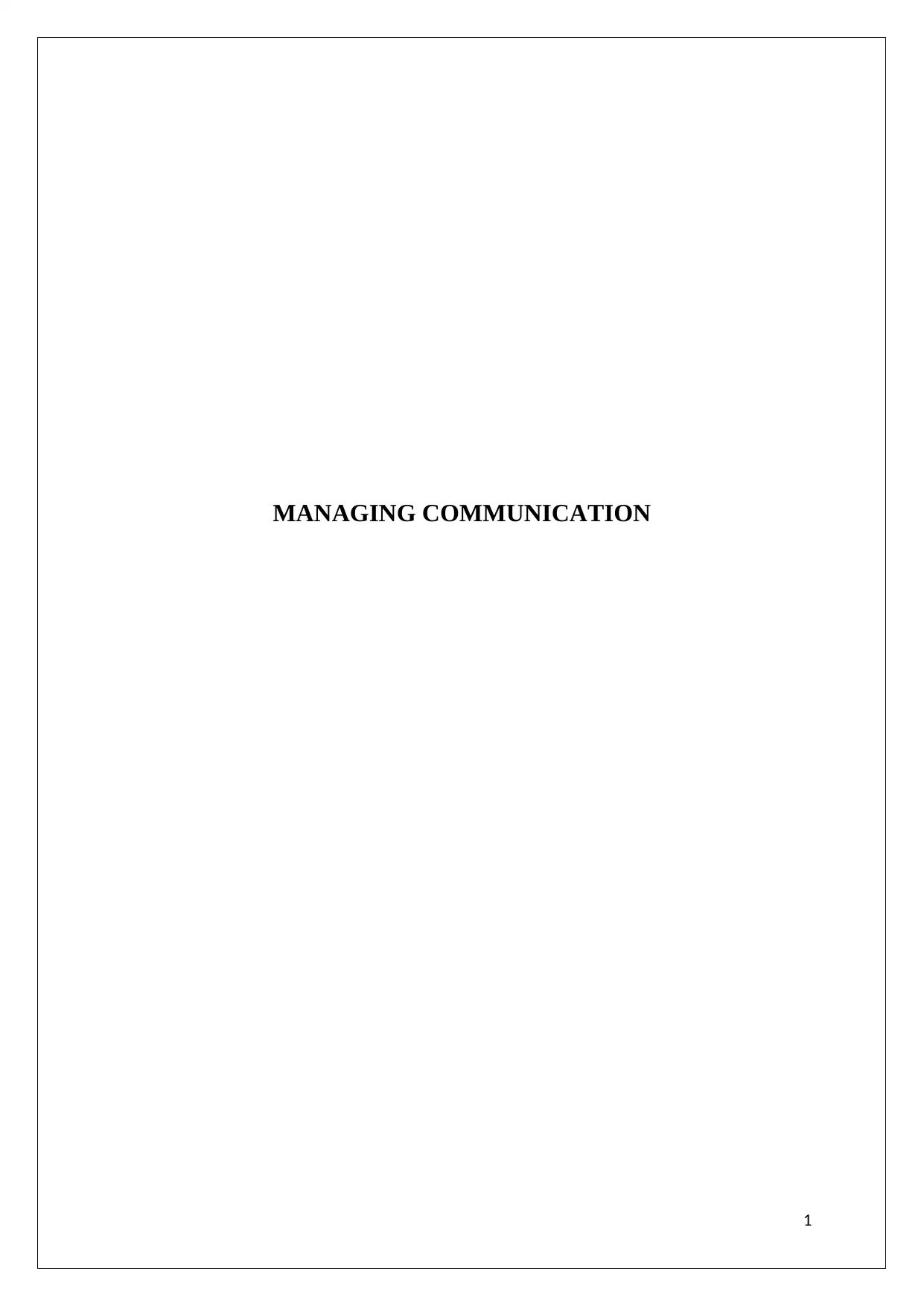
MANAGING COMMUNICATION
1
1
Paraphrase This Document
Need a fresh take? Get an instant paraphrase of this document with our AI Paraphraser
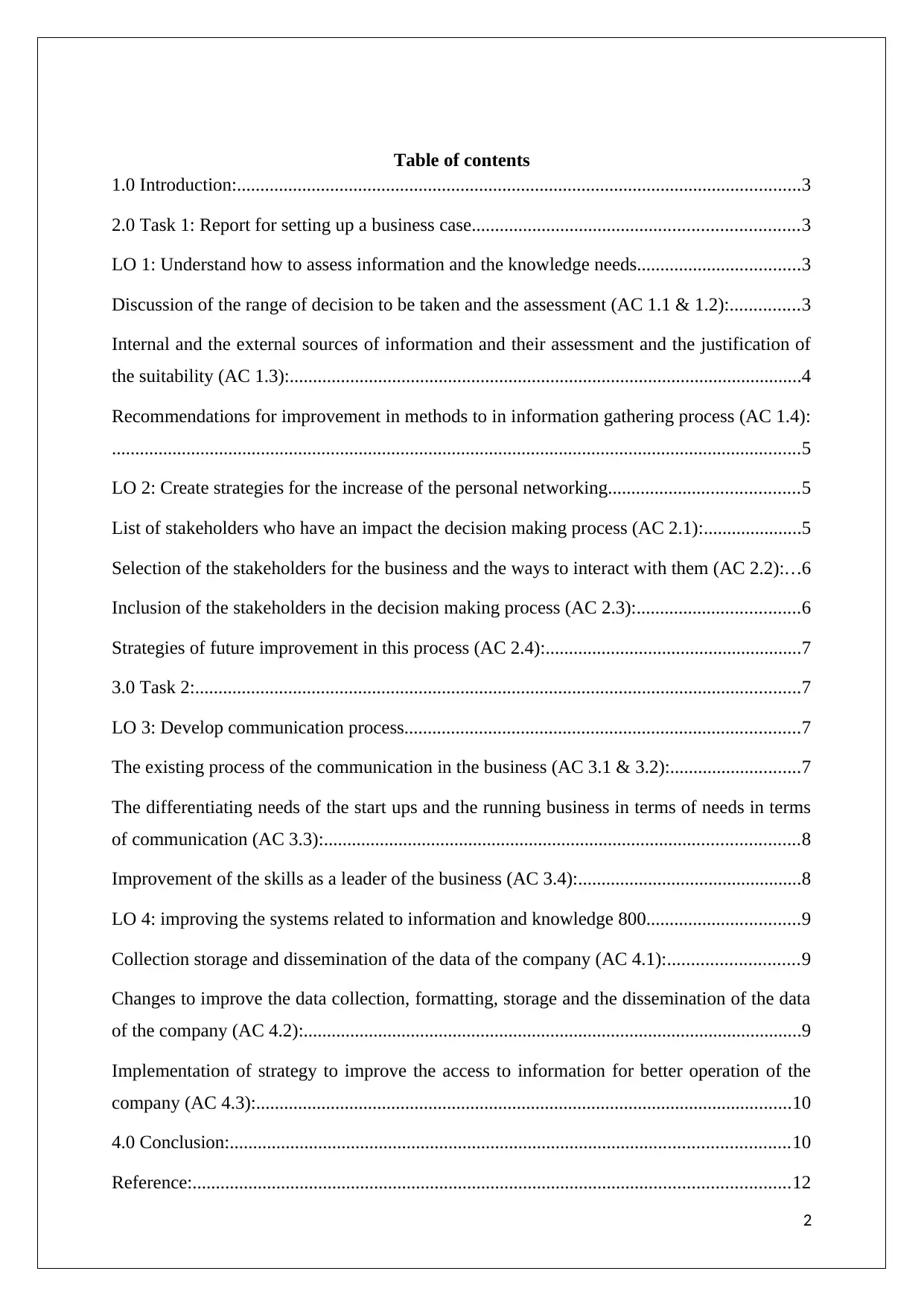
Table of contents
1.0 Introduction:.........................................................................................................................3
2.0 Task 1: Report for setting up a business case......................................................................3
LO 1: Understand how to assess information and the knowledge needs...................................3
Discussion of the range of decision to be taken and the assessment (AC 1.1 & 1.2):...............3
Internal and the external sources of information and their assessment and the justification of
the suitability (AC 1.3):..............................................................................................................4
Recommendations for improvement in methods to in information gathering process (AC 1.4):
....................................................................................................................................................5
LO 2: Create strategies for the increase of the personal networking.........................................5
List of stakeholders who have an impact the decision making process (AC 2.1):.....................5
Selection of the stakeholders for the business and the ways to interact with them (AC 2.2):...6
Inclusion of the stakeholders in the decision making process (AC 2.3):...................................6
Strategies of future improvement in this process (AC 2.4):.......................................................7
3.0 Task 2:..................................................................................................................................7
LO 3: Develop communication process.....................................................................................7
The existing process of the communication in the business (AC 3.1 & 3.2):............................7
The differentiating needs of the start ups and the running business in terms of needs in terms
of communication (AC 3.3):......................................................................................................8
Improvement of the skills as a leader of the business (AC 3.4):................................................8
LO 4: improving the systems related to information and knowledge 800.................................9
Collection storage and dissemination of the data of the company (AC 4.1):............................9
Changes to improve the data collection, formatting, storage and the dissemination of the data
of the company (AC 4.2):...........................................................................................................9
Implementation of strategy to improve the access to information for better operation of the
company (AC 4.3):...................................................................................................................10
4.0 Conclusion:........................................................................................................................10
Reference:................................................................................................................................12
2
1.0 Introduction:.........................................................................................................................3
2.0 Task 1: Report for setting up a business case......................................................................3
LO 1: Understand how to assess information and the knowledge needs...................................3
Discussion of the range of decision to be taken and the assessment (AC 1.1 & 1.2):...............3
Internal and the external sources of information and their assessment and the justification of
the suitability (AC 1.3):..............................................................................................................4
Recommendations for improvement in methods to in information gathering process (AC 1.4):
....................................................................................................................................................5
LO 2: Create strategies for the increase of the personal networking.........................................5
List of stakeholders who have an impact the decision making process (AC 2.1):.....................5
Selection of the stakeholders for the business and the ways to interact with them (AC 2.2):...6
Inclusion of the stakeholders in the decision making process (AC 2.3):...................................6
Strategies of future improvement in this process (AC 2.4):.......................................................7
3.0 Task 2:..................................................................................................................................7
LO 3: Develop communication process.....................................................................................7
The existing process of the communication in the business (AC 3.1 & 3.2):............................7
The differentiating needs of the start ups and the running business in terms of needs in terms
of communication (AC 3.3):......................................................................................................8
Improvement of the skills as a leader of the business (AC 3.4):................................................8
LO 4: improving the systems related to information and knowledge 800.................................9
Collection storage and dissemination of the data of the company (AC 4.1):............................9
Changes to improve the data collection, formatting, storage and the dissemination of the data
of the company (AC 4.2):...........................................................................................................9
Implementation of strategy to improve the access to information for better operation of the
company (AC 4.3):...................................................................................................................10
4.0 Conclusion:........................................................................................................................10
Reference:................................................................................................................................12
2
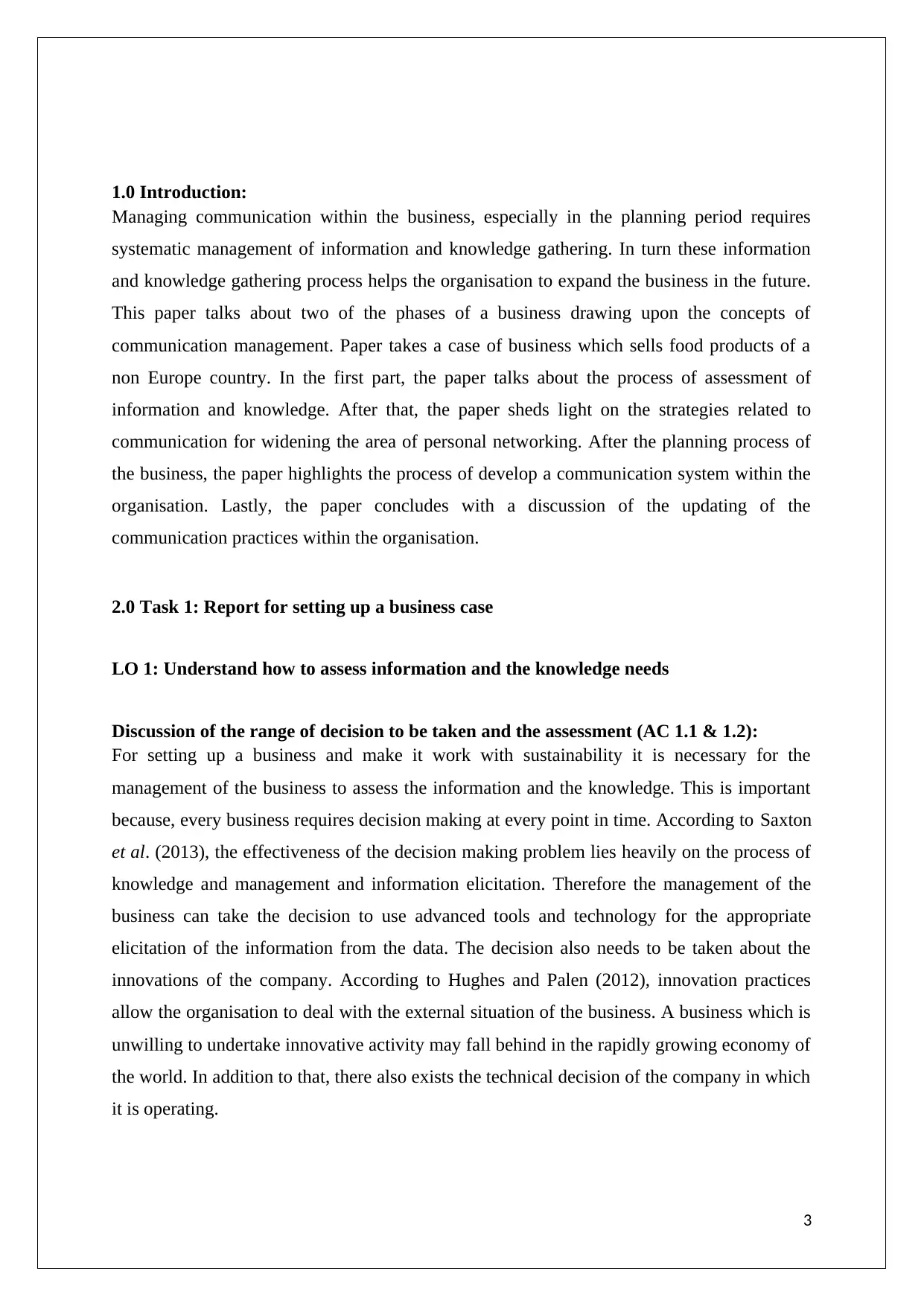
1.0 Introduction:
Managing communication within the business, especially in the planning period requires
systematic management of information and knowledge gathering. In turn these information
and knowledge gathering process helps the organisation to expand the business in the future.
This paper talks about two of the phases of a business drawing upon the concepts of
communication management. Paper takes a case of business which sells food products of a
non Europe country. In the first part, the paper talks about the process of assessment of
information and knowledge. After that, the paper sheds light on the strategies related to
communication for widening the area of personal networking. After the planning process of
the business, the paper highlights the process of develop a communication system within the
organisation. Lastly, the paper concludes with a discussion of the updating of the
communication practices within the organisation.
2.0 Task 1: Report for setting up a business case
LO 1: Understand how to assess information and the knowledge needs
Discussion of the range of decision to be taken and the assessment (AC 1.1 & 1.2):
For setting up a business and make it work with sustainability it is necessary for the
management of the business to assess the information and the knowledge. This is important
because, every business requires decision making at every point in time. According to Saxton
et al. (2013), the effectiveness of the decision making problem lies heavily on the process of
knowledge and management and information elicitation. Therefore the management of the
business can take the decision to use advanced tools and technology for the appropriate
elicitation of the information from the data. The decision also needs to be taken about the
innovations of the company. According to Hughes and Palen (2012), innovation practices
allow the organisation to deal with the external situation of the business. A business which is
unwilling to undertake innovative activity may fall behind in the rapidly growing economy of
the world. In addition to that, there also exists the technical decision of the company in which
it is operating.
3
Managing communication within the business, especially in the planning period requires
systematic management of information and knowledge gathering. In turn these information
and knowledge gathering process helps the organisation to expand the business in the future.
This paper talks about two of the phases of a business drawing upon the concepts of
communication management. Paper takes a case of business which sells food products of a
non Europe country. In the first part, the paper talks about the process of assessment of
information and knowledge. After that, the paper sheds light on the strategies related to
communication for widening the area of personal networking. After the planning process of
the business, the paper highlights the process of develop a communication system within the
organisation. Lastly, the paper concludes with a discussion of the updating of the
communication practices within the organisation.
2.0 Task 1: Report for setting up a business case
LO 1: Understand how to assess information and the knowledge needs
Discussion of the range of decision to be taken and the assessment (AC 1.1 & 1.2):
For setting up a business and make it work with sustainability it is necessary for the
management of the business to assess the information and the knowledge. This is important
because, every business requires decision making at every point in time. According to Saxton
et al. (2013), the effectiveness of the decision making problem lies heavily on the process of
knowledge and management and information elicitation. Therefore the management of the
business can take the decision to use advanced tools and technology for the appropriate
elicitation of the information from the data. The decision also needs to be taken about the
innovations of the company. According to Hughes and Palen (2012), innovation practices
allow the organisation to deal with the external situation of the business. A business which is
unwilling to undertake innovative activity may fall behind in the rapidly growing economy of
the world. In addition to that, there also exists the technical decision of the company in which
it is operating.
3
⊘ This is a preview!⊘
Do you want full access?
Subscribe today to unlock all pages.

Trusted by 1+ million students worldwide
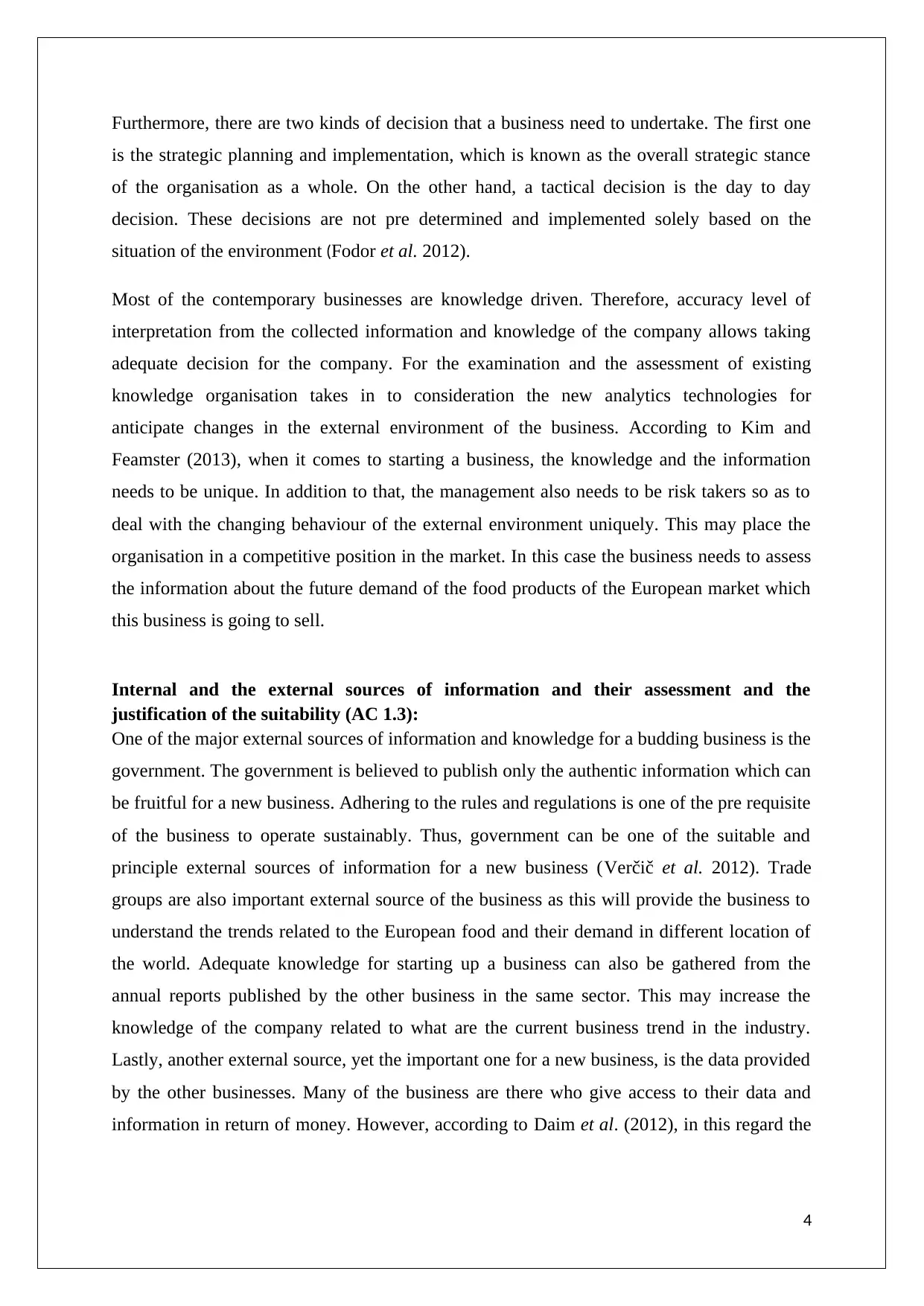
Furthermore, there are two kinds of decision that a business need to undertake. The first one
is the strategic planning and implementation, which is known as the overall strategic stance
of the organisation as a whole. On the other hand, a tactical decision is the day to day
decision. These decisions are not pre determined and implemented solely based on the
situation of the environment (Fodor et al. 2012).
Most of the contemporary businesses are knowledge driven. Therefore, accuracy level of
interpretation from the collected information and knowledge of the company allows taking
adequate decision for the company. For the examination and the assessment of existing
knowledge organisation takes in to consideration the new analytics technologies for
anticipate changes in the external environment of the business. According to Kim and
Feamster (2013), when it comes to starting a business, the knowledge and the information
needs to be unique. In addition to that, the management also needs to be risk takers so as to
deal with the changing behaviour of the external environment uniquely. This may place the
organisation in a competitive position in the market. In this case the business needs to assess
the information about the future demand of the food products of the European market which
this business is going to sell.
Internal and the external sources of information and their assessment and the
justification of the suitability (AC 1.3):
One of the major external sources of information and knowledge for a budding business is the
government. The government is believed to publish only the authentic information which can
be fruitful for a new business. Adhering to the rules and regulations is one of the pre requisite
of the business to operate sustainably. Thus, government can be one of the suitable and
principle external sources of information for a new business (Verčič et al. 2012). Trade
groups are also important external source of the business as this will provide the business to
understand the trends related to the European food and their demand in different location of
the world. Adequate knowledge for starting up a business can also be gathered from the
annual reports published by the other business in the same sector. This may increase the
knowledge of the company related to what are the current business trend in the industry.
Lastly, another external source, yet the important one for a new business, is the data provided
by the other businesses. Many of the business are there who give access to their data and
information in return of money. However, according to Daim et al. (2012), in this regard the
4
is the strategic planning and implementation, which is known as the overall strategic stance
of the organisation as a whole. On the other hand, a tactical decision is the day to day
decision. These decisions are not pre determined and implemented solely based on the
situation of the environment (Fodor et al. 2012).
Most of the contemporary businesses are knowledge driven. Therefore, accuracy level of
interpretation from the collected information and knowledge of the company allows taking
adequate decision for the company. For the examination and the assessment of existing
knowledge organisation takes in to consideration the new analytics technologies for
anticipate changes in the external environment of the business. According to Kim and
Feamster (2013), when it comes to starting a business, the knowledge and the information
needs to be unique. In addition to that, the management also needs to be risk takers so as to
deal with the changing behaviour of the external environment uniquely. This may place the
organisation in a competitive position in the market. In this case the business needs to assess
the information about the future demand of the food products of the European market which
this business is going to sell.
Internal and the external sources of information and their assessment and the
justification of the suitability (AC 1.3):
One of the major external sources of information and knowledge for a budding business is the
government. The government is believed to publish only the authentic information which can
be fruitful for a new business. Adhering to the rules and regulations is one of the pre requisite
of the business to operate sustainably. Thus, government can be one of the suitable and
principle external sources of information for a new business (Verčič et al. 2012). Trade
groups are also important external source of the business as this will provide the business to
understand the trends related to the European food and their demand in different location of
the world. Adequate knowledge for starting up a business can also be gathered from the
annual reports published by the other business in the same sector. This may increase the
knowledge of the company related to what are the current business trend in the industry.
Lastly, another external source, yet the important one for a new business, is the data provided
by the other businesses. Many of the business are there who give access to their data and
information in return of money. However, according to Daim et al. (2012), in this regard the
4
Paraphrase This Document
Need a fresh take? Get an instant paraphrase of this document with our AI Paraphraser
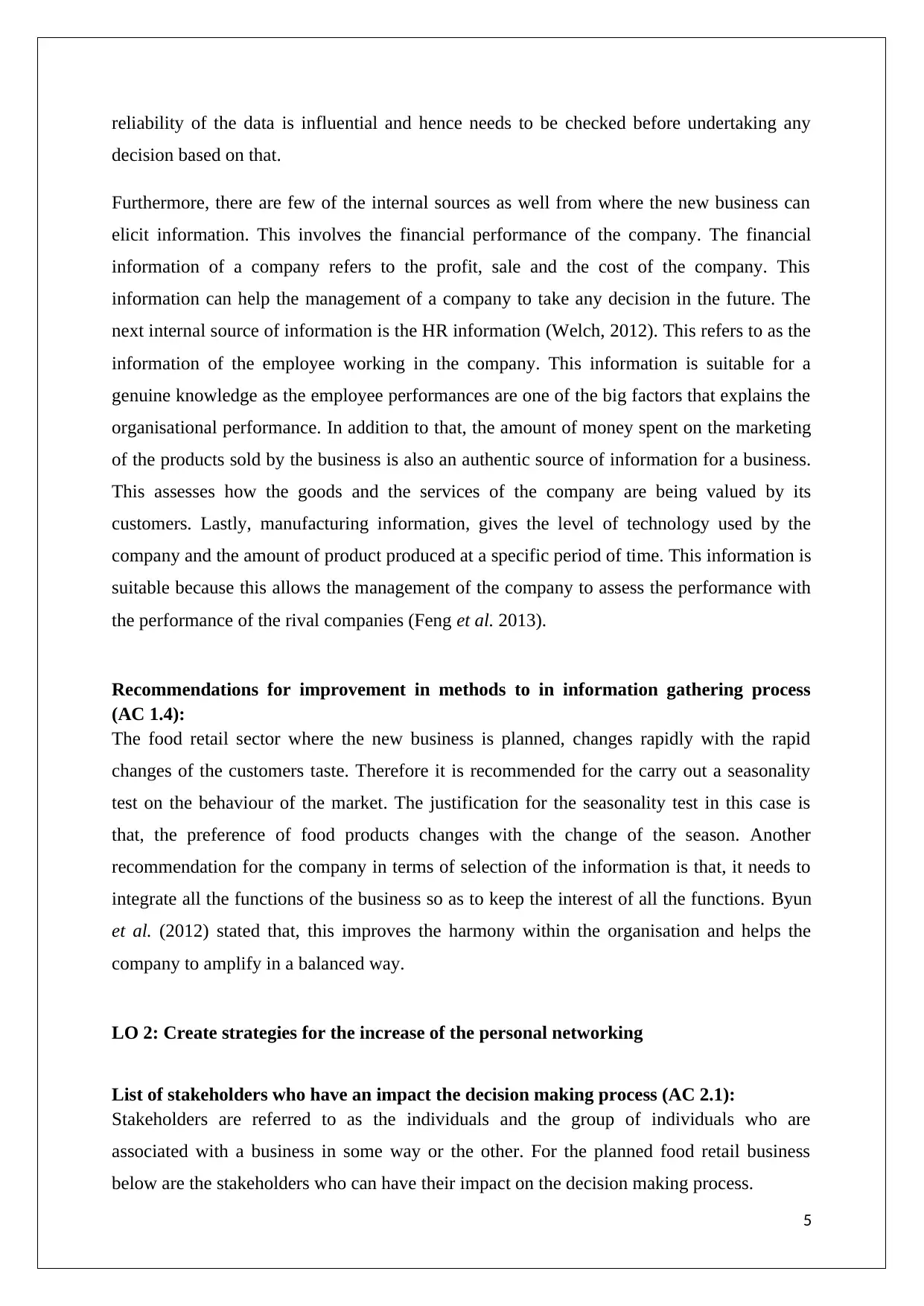
reliability of the data is influential and hence needs to be checked before undertaking any
decision based on that.
Furthermore, there are few of the internal sources as well from where the new business can
elicit information. This involves the financial performance of the company. The financial
information of a company refers to the profit, sale and the cost of the company. This
information can help the management of a company to take any decision in the future. The
next internal source of information is the HR information (Welch, 2012). This refers to as the
information of the employee working in the company. This information is suitable for a
genuine knowledge as the employee performances are one of the big factors that explains the
organisational performance. In addition to that, the amount of money spent on the marketing
of the products sold by the business is also an authentic source of information for a business.
This assesses how the goods and the services of the company are being valued by its
customers. Lastly, manufacturing information, gives the level of technology used by the
company and the amount of product produced at a specific period of time. This information is
suitable because this allows the management of the company to assess the performance with
the performance of the rival companies (Feng et al. 2013).
Recommendations for improvement in methods to in information gathering process
(AC 1.4):
The food retail sector where the new business is planned, changes rapidly with the rapid
changes of the customers taste. Therefore it is recommended for the carry out a seasonality
test on the behaviour of the market. The justification for the seasonality test in this case is
that, the preference of food products changes with the change of the season. Another
recommendation for the company in terms of selection of the information is that, it needs to
integrate all the functions of the business so as to keep the interest of all the functions. Byun
et al. (2012) stated that, this improves the harmony within the organisation and helps the
company to amplify in a balanced way.
LO 2: Create strategies for the increase of the personal networking
List of stakeholders who have an impact the decision making process (AC 2.1):
Stakeholders are referred to as the individuals and the group of individuals who are
associated with a business in some way or the other. For the planned food retail business
below are the stakeholders who can have their impact on the decision making process.
5
decision based on that.
Furthermore, there are few of the internal sources as well from where the new business can
elicit information. This involves the financial performance of the company. The financial
information of a company refers to the profit, sale and the cost of the company. This
information can help the management of a company to take any decision in the future. The
next internal source of information is the HR information (Welch, 2012). This refers to as the
information of the employee working in the company. This information is suitable for a
genuine knowledge as the employee performances are one of the big factors that explains the
organisational performance. In addition to that, the amount of money spent on the marketing
of the products sold by the business is also an authentic source of information for a business.
This assesses how the goods and the services of the company are being valued by its
customers. Lastly, manufacturing information, gives the level of technology used by the
company and the amount of product produced at a specific period of time. This information is
suitable because this allows the management of the company to assess the performance with
the performance of the rival companies (Feng et al. 2013).
Recommendations for improvement in methods to in information gathering process
(AC 1.4):
The food retail sector where the new business is planned, changes rapidly with the rapid
changes of the customers taste. Therefore it is recommended for the carry out a seasonality
test on the behaviour of the market. The justification for the seasonality test in this case is
that, the preference of food products changes with the change of the season. Another
recommendation for the company in terms of selection of the information is that, it needs to
integrate all the functions of the business so as to keep the interest of all the functions. Byun
et al. (2012) stated that, this improves the harmony within the organisation and helps the
company to amplify in a balanced way.
LO 2: Create strategies for the increase of the personal networking
List of stakeholders who have an impact the decision making process (AC 2.1):
Stakeholders are referred to as the individuals and the group of individuals who are
associated with a business in some way or the other. For the planned food retail business
below are the stakeholders who can have their impact on the decision making process.
5
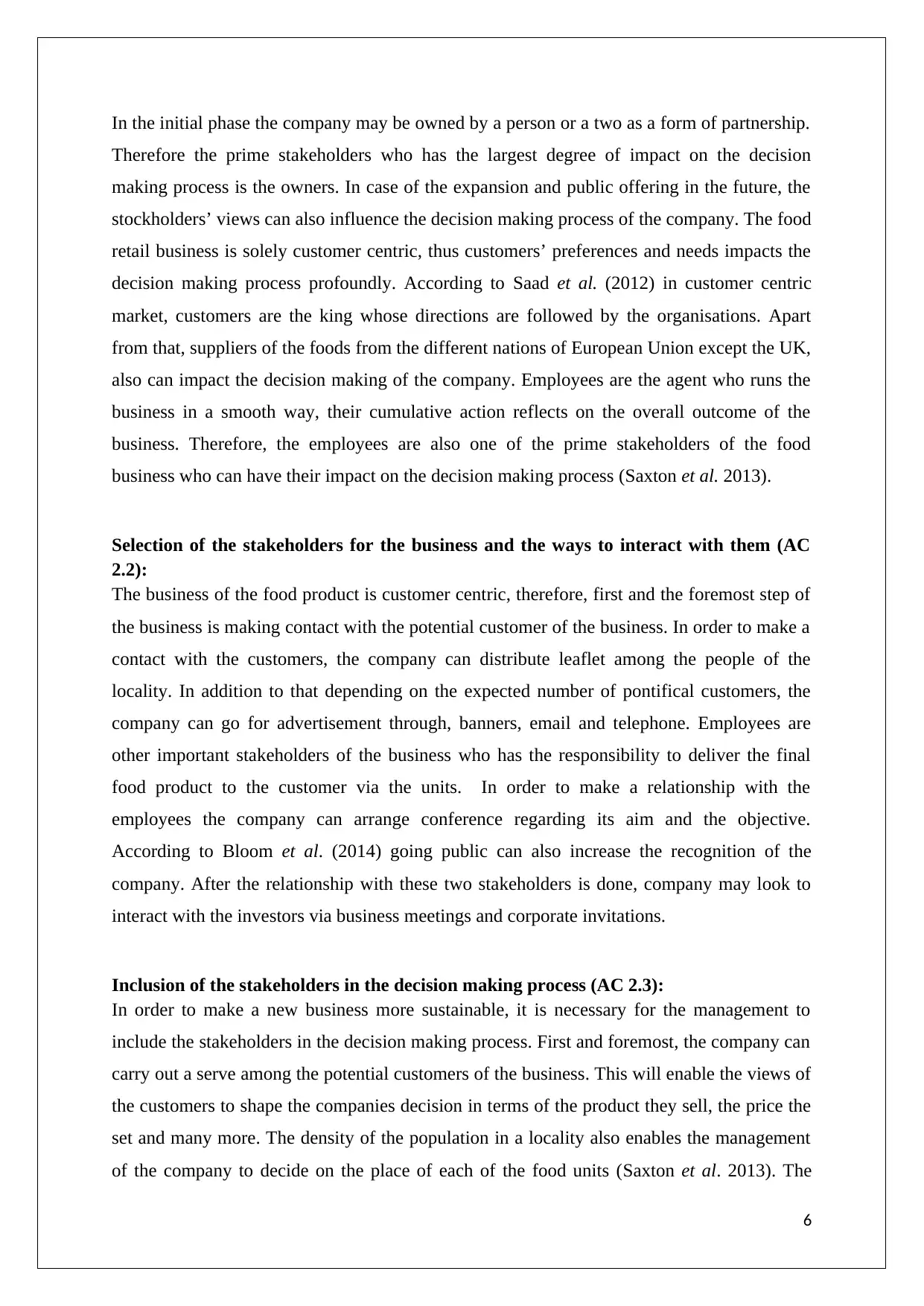
In the initial phase the company may be owned by a person or a two as a form of partnership.
Therefore the prime stakeholders who has the largest degree of impact on the decision
making process is the owners. In case of the expansion and public offering in the future, the
stockholders’ views can also influence the decision making process of the company. The food
retail business is solely customer centric, thus customers’ preferences and needs impacts the
decision making process profoundly. According to Saad et al. (2012) in customer centric
market, customers are the king whose directions are followed by the organisations. Apart
from that, suppliers of the foods from the different nations of European Union except the UK,
also can impact the decision making of the company. Employees are the agent who runs the
business in a smooth way, their cumulative action reflects on the overall outcome of the
business. Therefore, the employees are also one of the prime stakeholders of the food
business who can have their impact on the decision making process (Saxton et al. 2013).
Selection of the stakeholders for the business and the ways to interact with them (AC
2.2):
The business of the food product is customer centric, therefore, first and the foremost step of
the business is making contact with the potential customer of the business. In order to make a
contact with the customers, the company can distribute leaflet among the people of the
locality. In addition to that depending on the expected number of pontifical customers, the
company can go for advertisement through, banners, email and telephone. Employees are
other important stakeholders of the business who has the responsibility to deliver the final
food product to the customer via the units. In order to make a relationship with the
employees the company can arrange conference regarding its aim and the objective.
According to Bloom et al. (2014) going public can also increase the recognition of the
company. After the relationship with these two stakeholders is done, company may look to
interact with the investors via business meetings and corporate invitations.
Inclusion of the stakeholders in the decision making process (AC 2.3):
In order to make a new business more sustainable, it is necessary for the management to
include the stakeholders in the decision making process. First and foremost, the company can
carry out a serve among the potential customers of the business. This will enable the views of
the customers to shape the companies decision in terms of the product they sell, the price the
set and many more. The density of the population in a locality also enables the management
of the company to decide on the place of each of the food units (Saxton et al. 2013). The
6
Therefore the prime stakeholders who has the largest degree of impact on the decision
making process is the owners. In case of the expansion and public offering in the future, the
stockholders’ views can also influence the decision making process of the company. The food
retail business is solely customer centric, thus customers’ preferences and needs impacts the
decision making process profoundly. According to Saad et al. (2012) in customer centric
market, customers are the king whose directions are followed by the organisations. Apart
from that, suppliers of the foods from the different nations of European Union except the UK,
also can impact the decision making of the company. Employees are the agent who runs the
business in a smooth way, their cumulative action reflects on the overall outcome of the
business. Therefore, the employees are also one of the prime stakeholders of the food
business who can have their impact on the decision making process (Saxton et al. 2013).
Selection of the stakeholders for the business and the ways to interact with them (AC
2.2):
The business of the food product is customer centric, therefore, first and the foremost step of
the business is making contact with the potential customer of the business. In order to make a
contact with the customers, the company can distribute leaflet among the people of the
locality. In addition to that depending on the expected number of pontifical customers, the
company can go for advertisement through, banners, email and telephone. Employees are
other important stakeholders of the business who has the responsibility to deliver the final
food product to the customer via the units. In order to make a relationship with the
employees the company can arrange conference regarding its aim and the objective.
According to Bloom et al. (2014) going public can also increase the recognition of the
company. After the relationship with these two stakeholders is done, company may look to
interact with the investors via business meetings and corporate invitations.
Inclusion of the stakeholders in the decision making process (AC 2.3):
In order to make a new business more sustainable, it is necessary for the management to
include the stakeholders in the decision making process. First and foremost, the company can
carry out a serve among the potential customers of the business. This will enable the views of
the customers to shape the companies decision in terms of the product they sell, the price the
set and many more. The density of the population in a locality also enables the management
of the company to decide on the place of each of the food units (Saxton et al. 2013). The
6
⊘ This is a preview!⊘
Do you want full access?
Subscribe today to unlock all pages.

Trusted by 1+ million students worldwide
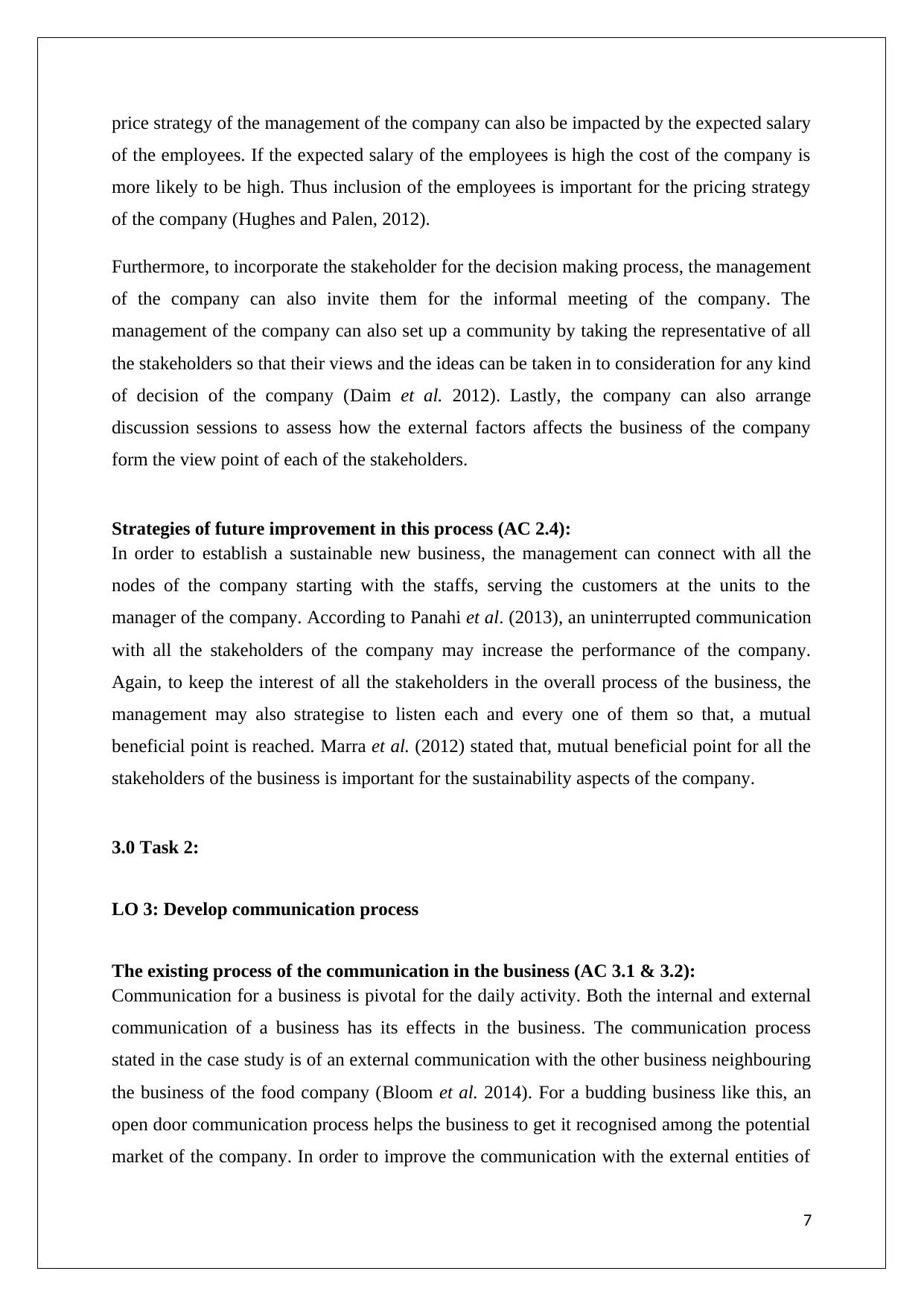
price strategy of the management of the company can also be impacted by the expected salary
of the employees. If the expected salary of the employees is high the cost of the company is
more likely to be high. Thus inclusion of the employees is important for the pricing strategy
of the company (Hughes and Palen, 2012).
Furthermore, to incorporate the stakeholder for the decision making process, the management
of the company can also invite them for the informal meeting of the company. The
management of the company can also set up a community by taking the representative of all
the stakeholders so that their views and the ideas can be taken in to consideration for any kind
of decision of the company (Daim et al. 2012). Lastly, the company can also arrange
discussion sessions to assess how the external factors affects the business of the company
form the view point of each of the stakeholders.
Strategies of future improvement in this process (AC 2.4):
In order to establish a sustainable new business, the management can connect with all the
nodes of the company starting with the staffs, serving the customers at the units to the
manager of the company. According to Panahi et al. (2013), an uninterrupted communication
with all the stakeholders of the company may increase the performance of the company.
Again, to keep the interest of all the stakeholders in the overall process of the business, the
management may also strategise to listen each and every one of them so that, a mutual
beneficial point is reached. Marra et al. (2012) stated that, mutual beneficial point for all the
stakeholders of the business is important for the sustainability aspects of the company.
3.0 Task 2:
LO 3: Develop communication process
The existing process of the communication in the business (AC 3.1 & 3.2):
Communication for a business is pivotal for the daily activity. Both the internal and external
communication of a business has its effects in the business. The communication process
stated in the case study is of an external communication with the other business neighbouring
the business of the food company (Bloom et al. 2014). For a budding business like this, an
open door communication process helps the business to get it recognised among the potential
market of the company. In order to improve the communication with the external entities of
7
of the employees. If the expected salary of the employees is high the cost of the company is
more likely to be high. Thus inclusion of the employees is important for the pricing strategy
of the company (Hughes and Palen, 2012).
Furthermore, to incorporate the stakeholder for the decision making process, the management
of the company can also invite them for the informal meeting of the company. The
management of the company can also set up a community by taking the representative of all
the stakeholders so that their views and the ideas can be taken in to consideration for any kind
of decision of the company (Daim et al. 2012). Lastly, the company can also arrange
discussion sessions to assess how the external factors affects the business of the company
form the view point of each of the stakeholders.
Strategies of future improvement in this process (AC 2.4):
In order to establish a sustainable new business, the management can connect with all the
nodes of the company starting with the staffs, serving the customers at the units to the
manager of the company. According to Panahi et al. (2013), an uninterrupted communication
with all the stakeholders of the company may increase the performance of the company.
Again, to keep the interest of all the stakeholders in the overall process of the business, the
management may also strategise to listen each and every one of them so that, a mutual
beneficial point is reached. Marra et al. (2012) stated that, mutual beneficial point for all the
stakeholders of the business is important for the sustainability aspects of the company.
3.0 Task 2:
LO 3: Develop communication process
The existing process of the communication in the business (AC 3.1 & 3.2):
Communication for a business is pivotal for the daily activity. Both the internal and external
communication of a business has its effects in the business. The communication process
stated in the case study is of an external communication with the other business neighbouring
the business of the food company (Bloom et al. 2014). For a budding business like this, an
open door communication process helps the business to get it recognised among the potential
market of the company. In order to improve the communication with the external entities of
7
Paraphrase This Document
Need a fresh take? Get an instant paraphrase of this document with our AI Paraphraser
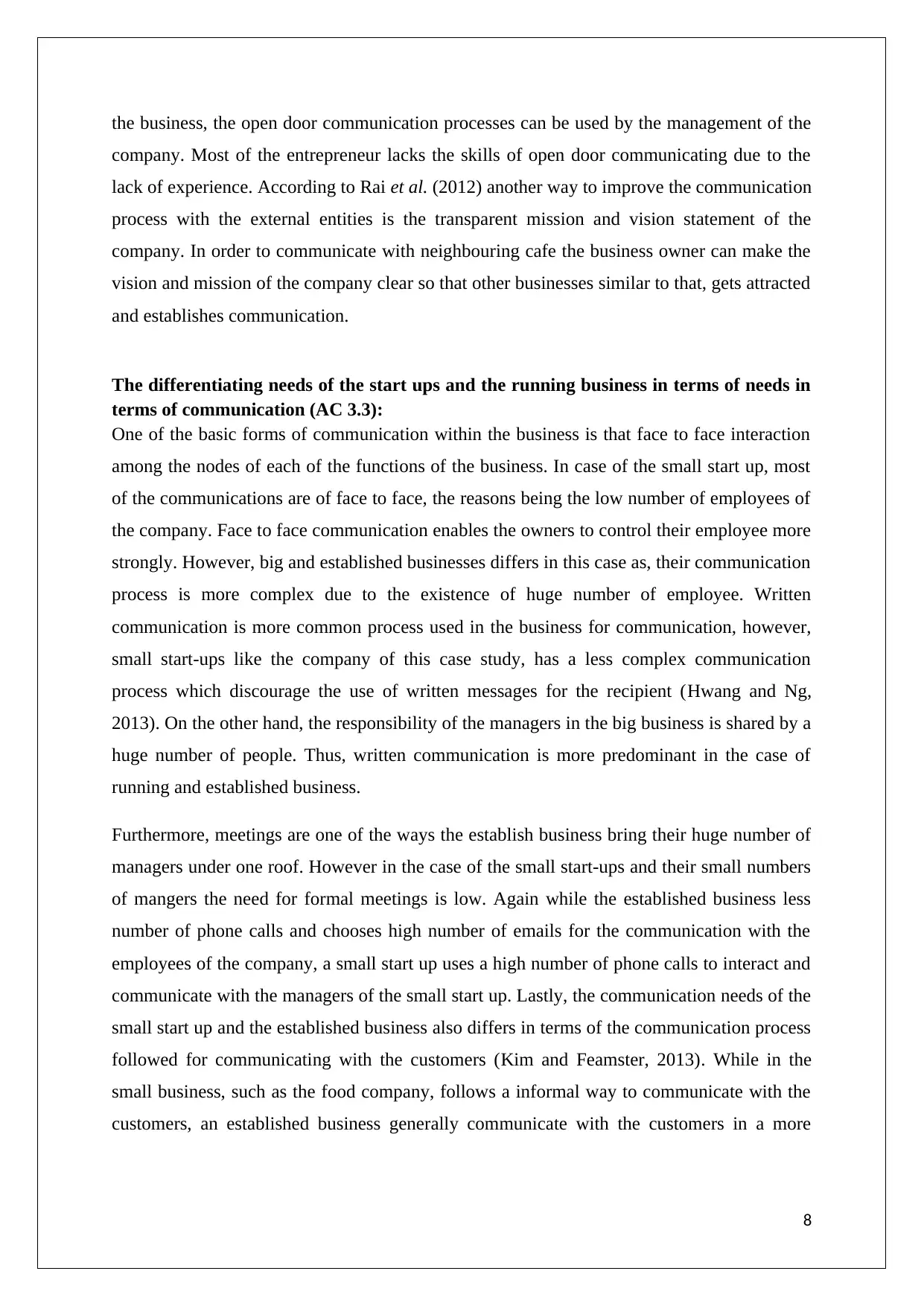
the business, the open door communication processes can be used by the management of the
company. Most of the entrepreneur lacks the skills of open door communicating due to the
lack of experience. According to Rai et al. (2012) another way to improve the communication
process with the external entities is the transparent mission and vision statement of the
company. In order to communicate with neighbouring cafe the business owner can make the
vision and mission of the company clear so that other businesses similar to that, gets attracted
and establishes communication.
The differentiating needs of the start ups and the running business in terms of needs in
terms of communication (AC 3.3):
One of the basic forms of communication within the business is that face to face interaction
among the nodes of each of the functions of the business. In case of the small start up, most
of the communications are of face to face, the reasons being the low number of employees of
the company. Face to face communication enables the owners to control their employee more
strongly. However, big and established businesses differs in this case as, their communication
process is more complex due to the existence of huge number of employee. Written
communication is more common process used in the business for communication, however,
small start-ups like the company of this case study, has a less complex communication
process which discourage the use of written messages for the recipient (Hwang and Ng,
2013). On the other hand, the responsibility of the managers in the big business is shared by a
huge number of people. Thus, written communication is more predominant in the case of
running and established business.
Furthermore, meetings are one of the ways the establish business bring their huge number of
managers under one roof. However in the case of the small start-ups and their small numbers
of mangers the need for formal meetings is low. Again while the established business less
number of phone calls and chooses high number of emails for the communication with the
employees of the company, a small start up uses a high number of phone calls to interact and
communicate with the managers of the small start up. Lastly, the communication needs of the
small start up and the established business also differs in terms of the communication process
followed for communicating with the customers (Kim and Feamster, 2013). While in the
small business, such as the food company, follows a informal way to communicate with the
customers, an established business generally communicate with the customers in a more
8
company. Most of the entrepreneur lacks the skills of open door communicating due to the
lack of experience. According to Rai et al. (2012) another way to improve the communication
process with the external entities is the transparent mission and vision statement of the
company. In order to communicate with neighbouring cafe the business owner can make the
vision and mission of the company clear so that other businesses similar to that, gets attracted
and establishes communication.
The differentiating needs of the start ups and the running business in terms of needs in
terms of communication (AC 3.3):
One of the basic forms of communication within the business is that face to face interaction
among the nodes of each of the functions of the business. In case of the small start up, most
of the communications are of face to face, the reasons being the low number of employees of
the company. Face to face communication enables the owners to control their employee more
strongly. However, big and established businesses differs in this case as, their communication
process is more complex due to the existence of huge number of employee. Written
communication is more common process used in the business for communication, however,
small start-ups like the company of this case study, has a less complex communication
process which discourage the use of written messages for the recipient (Hwang and Ng,
2013). On the other hand, the responsibility of the managers in the big business is shared by a
huge number of people. Thus, written communication is more predominant in the case of
running and established business.
Furthermore, meetings are one of the ways the establish business bring their huge number of
managers under one roof. However in the case of the small start-ups and their small numbers
of mangers the need for formal meetings is low. Again while the established business less
number of phone calls and chooses high number of emails for the communication with the
employees of the company, a small start up uses a high number of phone calls to interact and
communicate with the managers of the small start up. Lastly, the communication needs of the
small start up and the established business also differs in terms of the communication process
followed for communicating with the customers (Kim and Feamster, 2013). While in the
small business, such as the food company, follows a informal way to communicate with the
customers, an established business generally communicate with the customers in a more
8
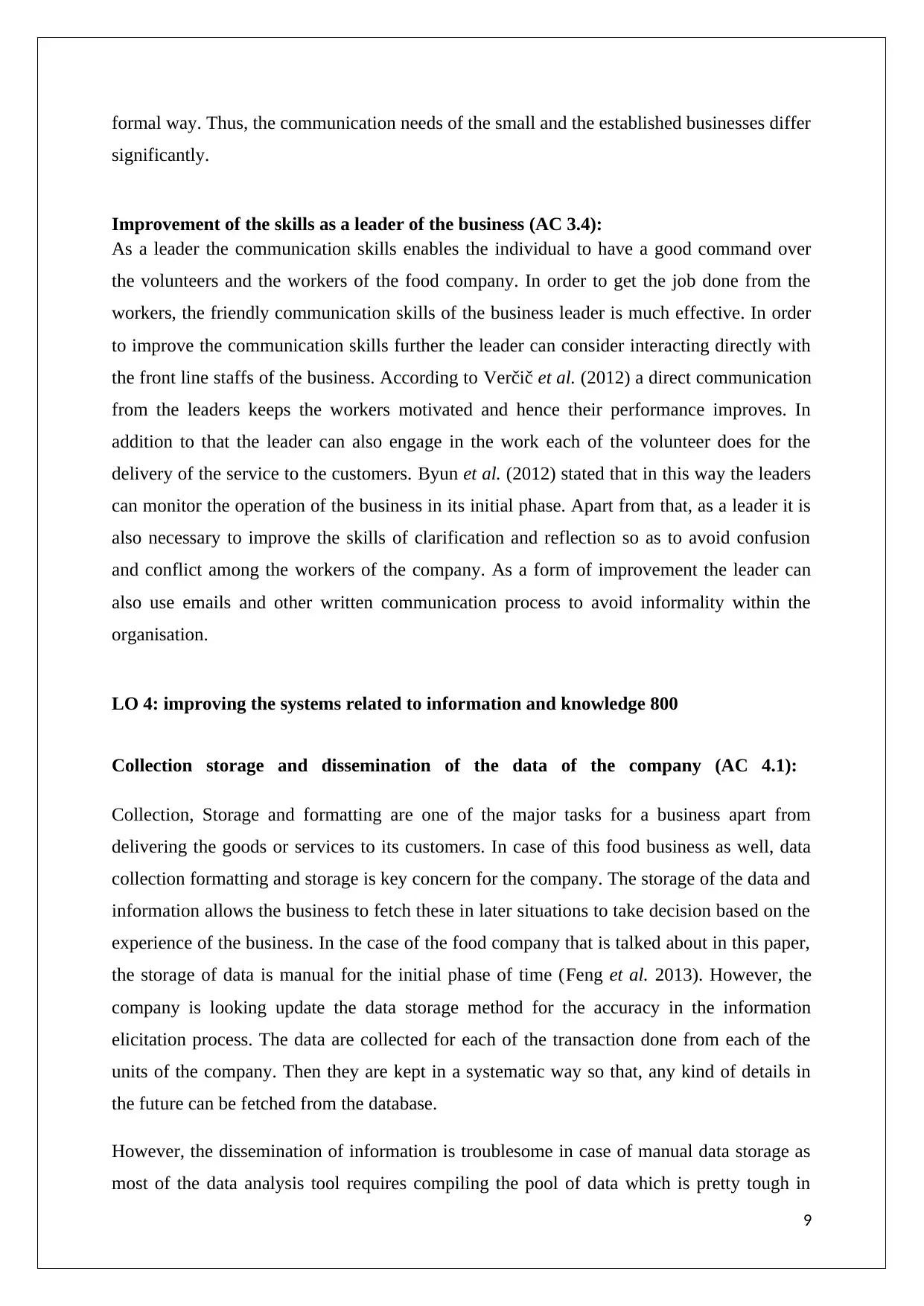
formal way. Thus, the communication needs of the small and the established businesses differ
significantly.
Improvement of the skills as a leader of the business (AC 3.4):
As a leader the communication skills enables the individual to have a good command over
the volunteers and the workers of the food company. In order to get the job done from the
workers, the friendly communication skills of the business leader is much effective. In order
to improve the communication skills further the leader can consider interacting directly with
the front line staffs of the business. According to Verčič et al. (2012) a direct communication
from the leaders keeps the workers motivated and hence their performance improves. In
addition to that the leader can also engage in the work each of the volunteer does for the
delivery of the service to the customers. Byun et al. (2012) stated that in this way the leaders
can monitor the operation of the business in its initial phase. Apart from that, as a leader it is
also necessary to improve the skills of clarification and reflection so as to avoid confusion
and conflict among the workers of the company. As a form of improvement the leader can
also use emails and other written communication process to avoid informality within the
organisation.
LO 4: improving the systems related to information and knowledge 800
Collection storage and dissemination of the data of the company (AC 4.1):
Collection, Storage and formatting are one of the major tasks for a business apart from
delivering the goods or services to its customers. In case of this food business as well, data
collection formatting and storage is key concern for the company. The storage of the data and
information allows the business to fetch these in later situations to take decision based on the
experience of the business. In the case of the food company that is talked about in this paper,
the storage of data is manual for the initial phase of time (Feng et al. 2013). However, the
company is looking update the data storage method for the accuracy in the information
elicitation process. The data are collected for each of the transaction done from each of the
units of the company. Then they are kept in a systematic way so that, any kind of details in
the future can be fetched from the database.
However, the dissemination of information is troublesome in case of manual data storage as
most of the data analysis tool requires compiling the pool of data which is pretty tough in
9
significantly.
Improvement of the skills as a leader of the business (AC 3.4):
As a leader the communication skills enables the individual to have a good command over
the volunteers and the workers of the food company. In order to get the job done from the
workers, the friendly communication skills of the business leader is much effective. In order
to improve the communication skills further the leader can consider interacting directly with
the front line staffs of the business. According to Verčič et al. (2012) a direct communication
from the leaders keeps the workers motivated and hence their performance improves. In
addition to that the leader can also engage in the work each of the volunteer does for the
delivery of the service to the customers. Byun et al. (2012) stated that in this way the leaders
can monitor the operation of the business in its initial phase. Apart from that, as a leader it is
also necessary to improve the skills of clarification and reflection so as to avoid confusion
and conflict among the workers of the company. As a form of improvement the leader can
also use emails and other written communication process to avoid informality within the
organisation.
LO 4: improving the systems related to information and knowledge 800
Collection storage and dissemination of the data of the company (AC 4.1):
Collection, Storage and formatting are one of the major tasks for a business apart from
delivering the goods or services to its customers. In case of this food business as well, data
collection formatting and storage is key concern for the company. The storage of the data and
information allows the business to fetch these in later situations to take decision based on the
experience of the business. In the case of the food company that is talked about in this paper,
the storage of data is manual for the initial phase of time (Feng et al. 2013). However, the
company is looking update the data storage method for the accuracy in the information
elicitation process. The data are collected for each of the transaction done from each of the
units of the company. Then they are kept in a systematic way so that, any kind of details in
the future can be fetched from the database.
However, the dissemination of information is troublesome in case of manual data storage as
most of the data analysis tool requires compiling the pool of data which is pretty tough in
9
⊘ This is a preview!⊘
Do you want full access?
Subscribe today to unlock all pages.

Trusted by 1+ million students worldwide
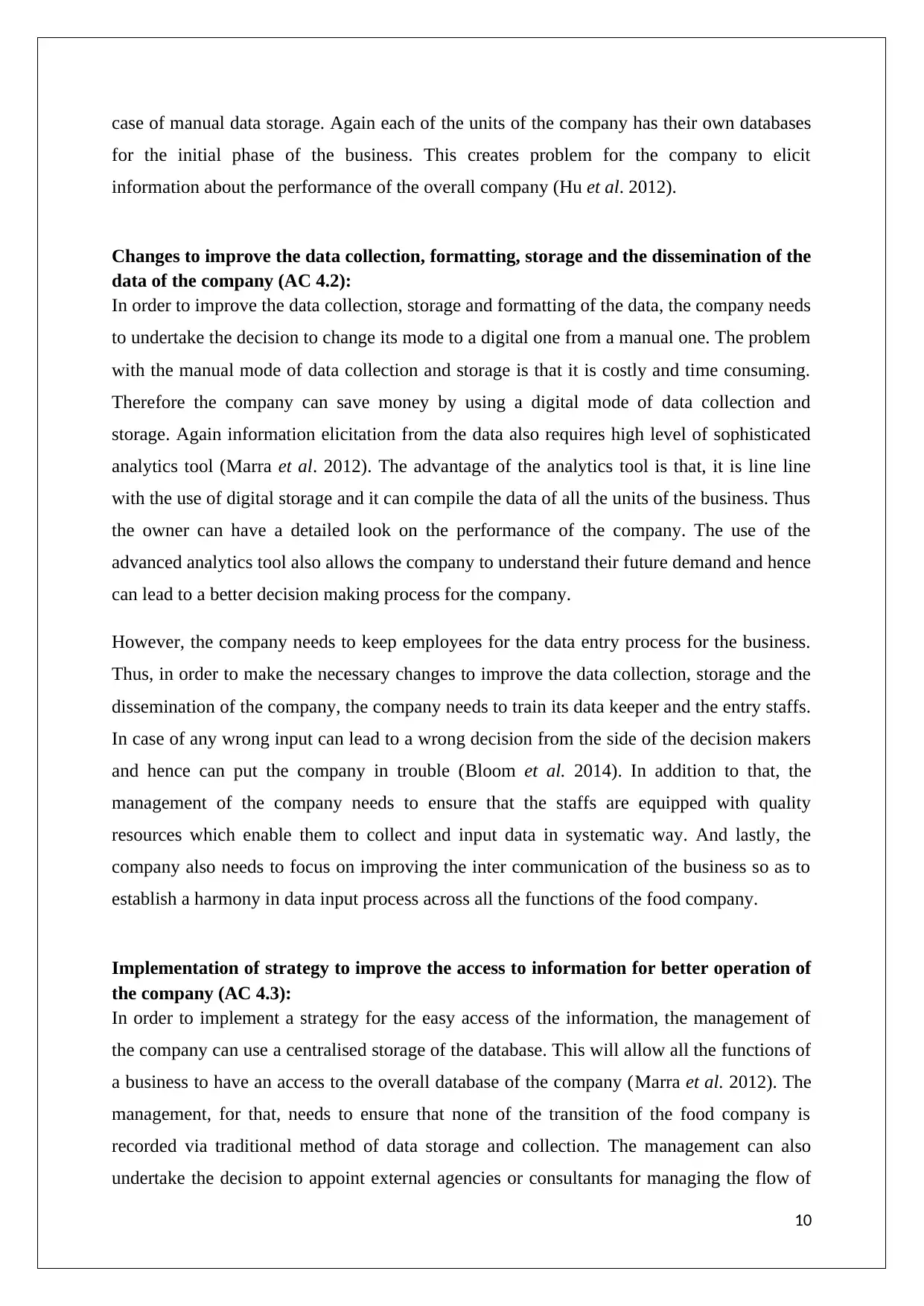
case of manual data storage. Again each of the units of the company has their own databases
for the initial phase of the business. This creates problem for the company to elicit
information about the performance of the overall company (Hu et al. 2012).
Changes to improve the data collection, formatting, storage and the dissemination of the
data of the company (AC 4.2):
In order to improve the data collection, storage and formatting of the data, the company needs
to undertake the decision to change its mode to a digital one from a manual one. The problem
with the manual mode of data collection and storage is that it is costly and time consuming.
Therefore the company can save money by using a digital mode of data collection and
storage. Again information elicitation from the data also requires high level of sophisticated
analytics tool (Marra et al. 2012). The advantage of the analytics tool is that, it is line line
with the use of digital storage and it can compile the data of all the units of the business. Thus
the owner can have a detailed look on the performance of the company. The use of the
advanced analytics tool also allows the company to understand their future demand and hence
can lead to a better decision making process for the company.
However, the company needs to keep employees for the data entry process for the business.
Thus, in order to make the necessary changes to improve the data collection, storage and the
dissemination of the company, the company needs to train its data keeper and the entry staffs.
In case of any wrong input can lead to a wrong decision from the side of the decision makers
and hence can put the company in trouble (Bloom et al. 2014). In addition to that, the
management of the company needs to ensure that the staffs are equipped with quality
resources which enable them to collect and input data in systematic way. And lastly, the
company also needs to focus on improving the inter communication of the business so as to
establish a harmony in data input process across all the functions of the food company.
Implementation of strategy to improve the access to information for better operation of
the company (AC 4.3):
In order to implement a strategy for the easy access of the information, the management of
the company can use a centralised storage of the database. This will allow all the functions of
a business to have an access to the overall database of the company (Marra et al. 2012). The
management, for that, needs to ensure that none of the transition of the food company is
recorded via traditional method of data storage and collection. The management can also
undertake the decision to appoint external agencies or consultants for managing the flow of
10
for the initial phase of the business. This creates problem for the company to elicit
information about the performance of the overall company (Hu et al. 2012).
Changes to improve the data collection, formatting, storage and the dissemination of the
data of the company (AC 4.2):
In order to improve the data collection, storage and formatting of the data, the company needs
to undertake the decision to change its mode to a digital one from a manual one. The problem
with the manual mode of data collection and storage is that it is costly and time consuming.
Therefore the company can save money by using a digital mode of data collection and
storage. Again information elicitation from the data also requires high level of sophisticated
analytics tool (Marra et al. 2012). The advantage of the analytics tool is that, it is line line
with the use of digital storage and it can compile the data of all the units of the business. Thus
the owner can have a detailed look on the performance of the company. The use of the
advanced analytics tool also allows the company to understand their future demand and hence
can lead to a better decision making process for the company.
However, the company needs to keep employees for the data entry process for the business.
Thus, in order to make the necessary changes to improve the data collection, storage and the
dissemination of the company, the company needs to train its data keeper and the entry staffs.
In case of any wrong input can lead to a wrong decision from the side of the decision makers
and hence can put the company in trouble (Bloom et al. 2014). In addition to that, the
management of the company needs to ensure that the staffs are equipped with quality
resources which enable them to collect and input data in systematic way. And lastly, the
company also needs to focus on improving the inter communication of the business so as to
establish a harmony in data input process across all the functions of the food company.
Implementation of strategy to improve the access to information for better operation of
the company (AC 4.3):
In order to implement a strategy for the easy access of the information, the management of
the company can use a centralised storage of the database. This will allow all the functions of
a business to have an access to the overall database of the company (Marra et al. 2012). The
management, for that, needs to ensure that none of the transition of the food company is
recorded via traditional method of data storage and collection. The management can also
undertake the decision to appoint external agencies or consultants for managing the flow of
10
Paraphrase This Document
Need a fresh take? Get an instant paraphrase of this document with our AI Paraphraser
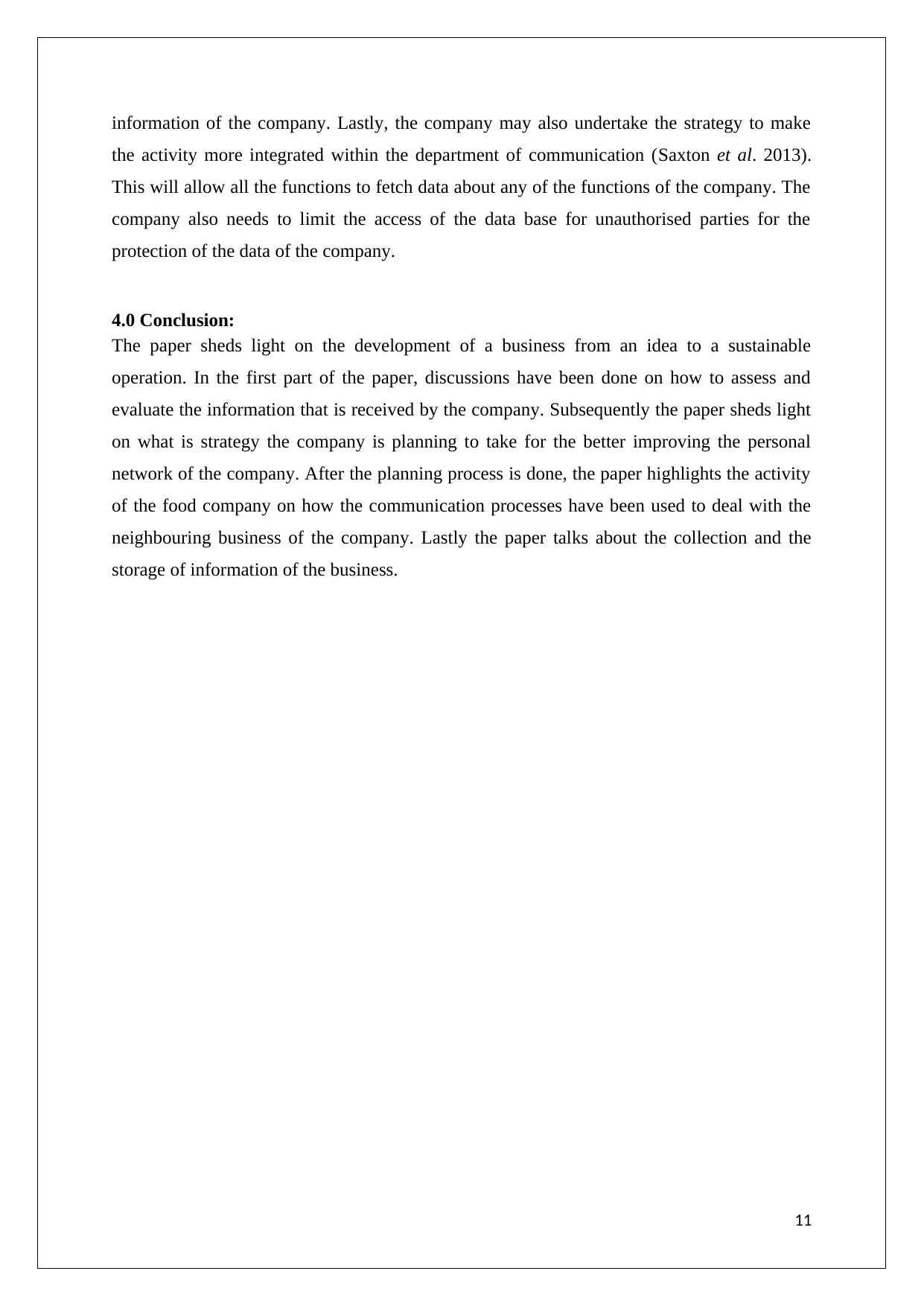
information of the company. Lastly, the company may also undertake the strategy to make
the activity more integrated within the department of communication (Saxton et al. 2013).
This will allow all the functions to fetch data about any of the functions of the company. The
company also needs to limit the access of the data base for unauthorised parties for the
protection of the data of the company.
4.0 Conclusion:
The paper sheds light on the development of a business from an idea to a sustainable
operation. In the first part of the paper, discussions have been done on how to assess and
evaluate the information that is received by the company. Subsequently the paper sheds light
on what is strategy the company is planning to take for the better improving the personal
network of the company. After the planning process is done, the paper highlights the activity
of the food company on how the communication processes have been used to deal with the
neighbouring business of the company. Lastly the paper talks about the collection and the
storage of information of the business.
11
the activity more integrated within the department of communication (Saxton et al. 2013).
This will allow all the functions to fetch data about any of the functions of the company. The
company also needs to limit the access of the data base for unauthorised parties for the
protection of the data of the company.
4.0 Conclusion:
The paper sheds light on the development of a business from an idea to a sustainable
operation. In the first part of the paper, discussions have been done on how to assess and
evaluate the information that is received by the company. Subsequently the paper sheds light
on what is strategy the company is planning to take for the better improving the personal
network of the company. After the planning process is done, the paper highlights the activity
of the food company on how the communication processes have been used to deal with the
neighbouring business of the company. Lastly the paper talks about the collection and the
storage of information of the business.
11
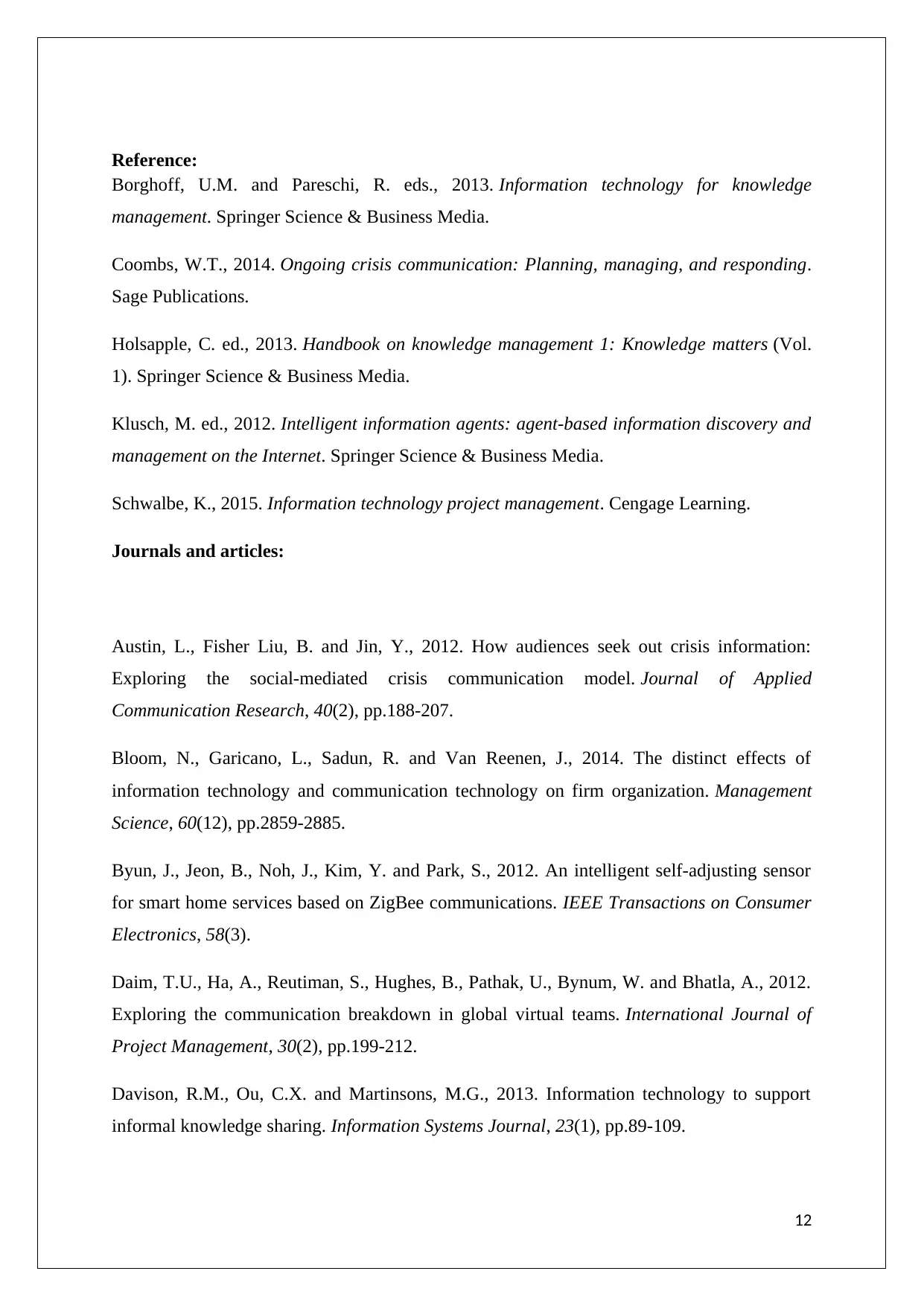
Reference:
Borghoff, U.M. and Pareschi, R. eds., 2013. Information technology for knowledge
management. Springer Science & Business Media.
Coombs, W.T., 2014. Ongoing crisis communication: Planning, managing, and responding.
Sage Publications.
Holsapple, C. ed., 2013. Handbook on knowledge management 1: Knowledge matters (Vol.
1). Springer Science & Business Media.
Klusch, M. ed., 2012. Intelligent information agents: agent-based information discovery and
management on the Internet. Springer Science & Business Media.
Schwalbe, K., 2015. Information technology project management. Cengage Learning.
Journals and articles:
Austin, L., Fisher Liu, B. and Jin, Y., 2012. How audiences seek out crisis information:
Exploring the social-mediated crisis communication model. Journal of Applied
Communication Research, 40(2), pp.188-207.
Bloom, N., Garicano, L., Sadun, R. and Van Reenen, J., 2014. The distinct effects of
information technology and communication technology on firm organization. Management
Science, 60(12), pp.2859-2885.
Byun, J., Jeon, B., Noh, J., Kim, Y. and Park, S., 2012. An intelligent self-adjusting sensor
for smart home services based on ZigBee communications. IEEE Transactions on Consumer
Electronics, 58(3).
Daim, T.U., Ha, A., Reutiman, S., Hughes, B., Pathak, U., Bynum, W. and Bhatla, A., 2012.
Exploring the communication breakdown in global virtual teams. International Journal of
Project Management, 30(2), pp.199-212.
Davison, R.M., Ou, C.X. and Martinsons, M.G., 2013. Information technology to support
informal knowledge sharing. Information Systems Journal, 23(1), pp.89-109.
12
Borghoff, U.M. and Pareschi, R. eds., 2013. Information technology for knowledge
management. Springer Science & Business Media.
Coombs, W.T., 2014. Ongoing crisis communication: Planning, managing, and responding.
Sage Publications.
Holsapple, C. ed., 2013. Handbook on knowledge management 1: Knowledge matters (Vol.
1). Springer Science & Business Media.
Klusch, M. ed., 2012. Intelligent information agents: agent-based information discovery and
management on the Internet. Springer Science & Business Media.
Schwalbe, K., 2015. Information technology project management. Cengage Learning.
Journals and articles:
Austin, L., Fisher Liu, B. and Jin, Y., 2012. How audiences seek out crisis information:
Exploring the social-mediated crisis communication model. Journal of Applied
Communication Research, 40(2), pp.188-207.
Bloom, N., Garicano, L., Sadun, R. and Van Reenen, J., 2014. The distinct effects of
information technology and communication technology on firm organization. Management
Science, 60(12), pp.2859-2885.
Byun, J., Jeon, B., Noh, J., Kim, Y. and Park, S., 2012. An intelligent self-adjusting sensor
for smart home services based on ZigBee communications. IEEE Transactions on Consumer
Electronics, 58(3).
Daim, T.U., Ha, A., Reutiman, S., Hughes, B., Pathak, U., Bynum, W. and Bhatla, A., 2012.
Exploring the communication breakdown in global virtual teams. International Journal of
Project Management, 30(2), pp.199-212.
Davison, R.M., Ou, C.X. and Martinsons, M.G., 2013. Information technology to support
informal knowledge sharing. Information Systems Journal, 23(1), pp.89-109.
12
⊘ This is a preview!⊘
Do you want full access?
Subscribe today to unlock all pages.

Trusted by 1+ million students worldwide
1 out of 14
Related Documents
Your All-in-One AI-Powered Toolkit for Academic Success.
+13062052269
info@desklib.com
Available 24*7 on WhatsApp / Email
![[object Object]](/_next/static/media/star-bottom.7253800d.svg)
Unlock your academic potential
Copyright © 2020–2025 A2Z Services. All Rights Reserved. Developed and managed by ZUCOL.





